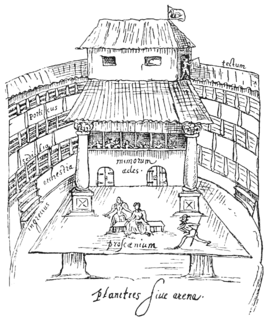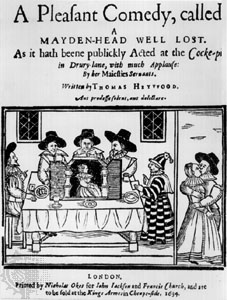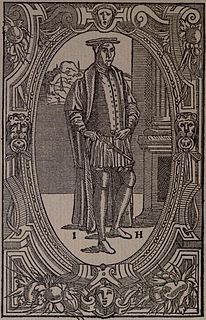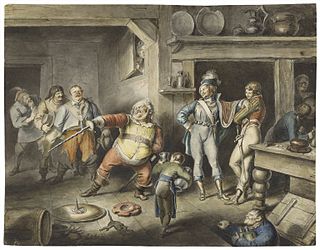Related Research Articles

English Renaissance theatre, also known as Renaissance English theatre and Elizabethan theatre, refers to the theatre of England between 1558 and 1642.

Thomas Heywood was an English playwright, actor, and author. His main contributions were to late Elizabethan and early Jacobean theatre. He is best known for his masterpiece A Woman Killed with Kindness, a domestic tragedy, which was first performed in 1603 at the Rose Theatre by the Worcester's Men company. He was a prolific writer, claiming to have had "an entire hand or at least a maine finger in two hundred and twenty plays", although only a fraction of his work has survived.
Polydore Vergil or Virgil, widely known as Polydore Vergil of Urbino, was an Italian humanist scholar, historian, priest and diplomat, who spent much of his life in England. He is particularly remembered for his works the Proverbiorum libellus (1498), a collection of Latin proverbs; De inventoribus rerum (1499), a history of discoveries and origins; and the Anglica Historia, an influential history of England. He has been dubbed the "Father of English History".

Twelfth Night, or What You Will is a romantic comedy by William Shakespeare, believed to have been written around 1601–1602 as a Twelfth Night's entertainment for the close of the Christmas season. The play centres on the twins Viola and Sebastian, who are separated in a shipwreck. Viola falls in love with the Duke Orsino, who in turn is in love with Countess Olivia. Upon meeting Viola, Countess Olivia falls in love with her thinking she is a man.

John Heywood was an English writer known for his plays, poems, and collection of proverbs. Although he is best known as a playwright, he was also active as a musician and composer, though no musical works survive. A devout Catholic, he nevertheless served as a royal servant to both the Catholic and Protestant regimes of Henry VIII, Edward VI, Mary I and Elizabeth I.

Gil Vicente, called the Trobadour, was a Portuguese playwright and poet who acted in and directed his own plays. Considered the chief dramatist of Portugal he is sometimes called the "Portuguese Plautus," often referred to as the "Father of Portuguese drama" and as one of Western literature's greatest playwrights. Also noted as a lyric poet, Vicente worked in Spanish as much as he worked in Portuguese and is thus, with Juan del Encina, considered joint-father of Spanish drama.

A New Way to Pay Old Debts is an English Renaissance drama, the most popular play by Philip Massinger. Its central character, Sir Giles Over-reach, became one of the more popular villains on English and American stages through the 19th century.

Medieval French literature is, for the purpose of this article, Medieval literature written in Oïl languages during the period from the eleventh century to the end of the fifteenth century.
Vice is a stock character of the medieval morality plays. While the main character of these plays was representative of every human being, the other characters were representatives of personified virtues or vices who sought to win control of man's soul. While the virtues in a morality play can be seen as messengers of God, the vices were viewed as messengers of the Devil.
PLS, or Poculi Ludique Societas, the Medieval & Renaissance Players of Toronto, sponsors productions of early plays, from the beginnings of medieval drama to as late as the middle of the seventeenth century.
A Woman Killed with Kindness is an early seventeenth-century stage play, a tragedy written by Thomas Heywood. Acted in 1603 and first published in 1607, the play has generally been considered Heywood's masterpiece, and has received the most critical attention among Heywood's works. Along with the anonymous Arden of Faversham, Heywood's play has been regarded as the apex of Renaissance drama's achievement in the subgenre of bourgeois or domestic tragedy.

The Fair Maid of the West, or a Girl Worth Gold, Parts 1 and 2 is a work of English Renaissance drama, a two-part play written by Thomas Heywood that was first published in 1631.
Fortune by Land and Sea is a Jacobean era stage play, a romantic melodrama written by Thomas Heywood and William Rowley. The play has attracted the attention of modern critics for its juxtaposition of the themes of primogeniture and piracy.

How He Lied to Her Husband is a one-act comedy play by George Bernard Shaw, who wrote it, at the request of actor Arnold Daly, over a period of four days while he was vacationing in Scotland in 1904. In its preface he described it as "a sample of what can be done with even the most hackneyed stage framework by filling it in with an observed touch of actual humanity instead of with doctrinaire romanticism." The play has often been interpreted as a kind of satirical commentary on Shaw's own highly successful earlier play Candida.
The early plays of Henry Fielding mark the beginning of Fielding's literary career. His early plays span the time period from his first production in 1728 to the beginning of the Actor's Rebellion of 1733, a strife within the Theatre Royal, Drury Lane that divided the theatrical community and threatened to disrupt London stage performances. These plays introduce Fielding's take on politics, gender, and morality and serve as an early basis for how Fielding develops his ideas on these matters throughout his career.
The Play of the Weather is an English interlude or morality play from the early Tudor period. The play was written by John Heywood, a courtier, musician and playwright during the reigns of Henry VIII, Edward VI and Mary I and published by his brother-in-law, William Rastell, in 1533 as The Play of the Wether, a new and mery interlude of all maner of Wethers. It represents the Roman deity Jupiter on earth asking mortals to make cases for their preferred weather following heavenly dissension among the gods. It is the first published play to nominate "The Vice" on its title page.

History is one of the three main genres in Western theatre alongside tragedy and comedy, although it originated, in its modern form, thousands of years later than the other primary genres. For this reason, it is often treated as a subset of tragedy. A play in this genre is known as a history play and is based on a historical narrative, often set in the medieval or early modern past. History emerged as a distinct genre from tragedy in Renaissance England. The best known examples of the genre are the history plays written by William Shakespeare, whose plays still serve to define the genre. History plays also appear elsewhere in British and Western literature, such as Thomas Heywood's Edward IV, Schiller's Mary Stuart or the Dutch genre Gijsbrecht van Aemstel.
Cupid’s Whirligig, by Edward Sharpham (1576-1608), is a city comedy set in London about a husband that suspects his wife of having affairs with other men and is consumed with irrational jealousy. It was first published in quarto in 1607, entered in the Stationer’s Register with the name "A Comedie called Cupids Whirlegigge." It was performed that year by the Children of the King’s Revels in the Whitefriars Theatre where Ben Jonson’s Epicene was also said to have been performed.
The English Traveller is a seventeenth-century tragicomedy in five acts written by Thomas Heywood, and named as such by the playwright. The play was first performed around the year 1627, and the first printed edition came out in 1633. Consisting of two mostly self-contained, but thematically connected plots, one tragic and one comic, it trafficks in the elements of both city comedy and domestic tragedy. In the tragic plot, the recently returned traveler Young Geraldine contemplates forbidden love with the wife of his father's friend Wincott. In the comic plot, the rascal servant Reignald attempts an elaborate cover-up for Young Lionell's drunken party once his father returns from his mercantile voyages. Critics have recognized this as an important work of drama for its generic experimentation, for its investigation of the relationship between appearances and reality, and for its commentary on Renaissance households.

The Wise Woman of Hoxton is a city comedy by the early modern English playwright Thomas Heywood. It was published under the title The Wise-Woman of Hogsdon in 1638, though it was probably first performed c. 1604 by the Queen's Men company, either at The Curtain or perhaps The Red Bull. The play is set in Hoxton, an area that at the time was outside the boundaries of the city of London and notorious for its entertainments and recreations. The Victorian critic F. G. Fleay suggested that Heywood, who was also an actor, originally played the part of Sencer. It has often been compared with Ben Jonson's comic masterpiece The Alchemist (1610)—the poet T. S. Eliot, for example, argued that with this play Heywood "succeeds with something not too far below Jonson to be comparable to that master's work".
References
- ↑ Database of Early English Playbooks http://deep.sas.upenn.edu/index.html
- ↑ Borowska-Szerszun, Sylwia. (2007). "The Unruly Household in John Heywood's John John". Studia Anglica Posnaniensia: International Review of English Studies 43.
- ↑ Borowska-Szerszun, Sylwia. (2007). "The Unruly Household in John Heywood's John John". Studia Anglica Posnaniensia: International Review of English Studies 43.
- ↑ Database of Early English Playbooks http://deep.sas.upenn.edu/index.html
- ↑ Craik, T.W. (1950). "The True Source of John Heywood's 'John John'". The Modern Language Review 45(3), 289-295.